30 October 2023
![]() 21 mins Read
21 mins Read
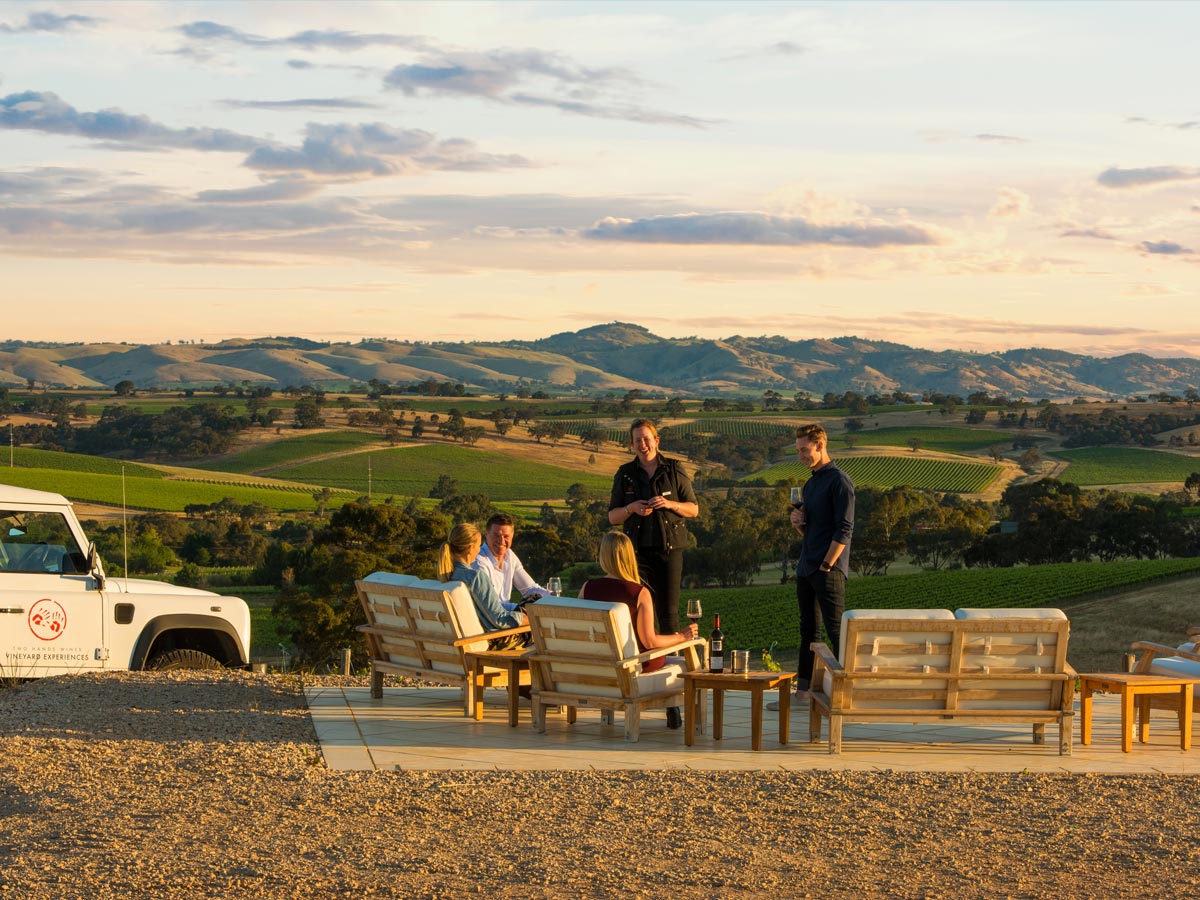
Australia is spoilt for sublime grape-crushing terrain, but none boasts more perfect a setting than South Australia’s Barossa Valley. A killer winemaking climate, endless views of colossal rolling hills, smudgy pastel sunsets and opulent cellar doors make wineries in the Barossa Valley the stuff of romantic weekender dreams. Our edit of the very best Barossa wineries is begging to be explored.
Set above the Barossa at Angaston, Yalumba remains one of the only major Barossa wineries under family ownership and an unwavering drawcard for crowds. As you pull up to the superbly manicured grounds, there’s little sense of the grandeur around the corner – a blue-marble winery with one remarkably photogenic clocktower.
Yalumba was established by the Hill-Smith family in 1849, and nods to its heritage, including a stash of colourful wagons and fascinating photo albums, are everywhere. The icing on the cake is Yalumba’s on-site cooperage, crafting barrels and casks, which is one of just five operational cooperages in the world.
And what of the wines? Although Yalumba creates traditional high-end reds (like The Menzies Cabernet Sauvignon, and The Signature Cabernet Sauvignon/Shiraz blend) plus popular bubblies (Angas Brut), it’s also an innovator. It first planted the Viognier grape in 1980 and now produces one of the finest bottles of the stuff.
Tours of the grounds, picnic packs and wine ambassador talks add to the long list of Yalumba’s unmissable charms.
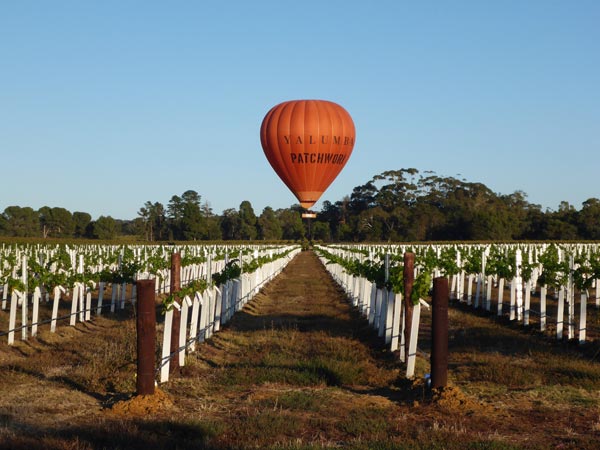
The Barossa is a weekender dream destination. (Image: Exploring9to5)
This monumental bluestone winery, along the gorgeous palm-lined Seppeltsfield Road, encapsulates the vision and prodigious work ethic of the many Germans who settled the Barossa. In Seppeltsfield’s case, it’s Joseph Seppelt, the Silesian migrant who planted the very first vines here in 1851. It’s vast and impressive, with ancient wine barrels, displays of historical artefacts and expansive grounds.
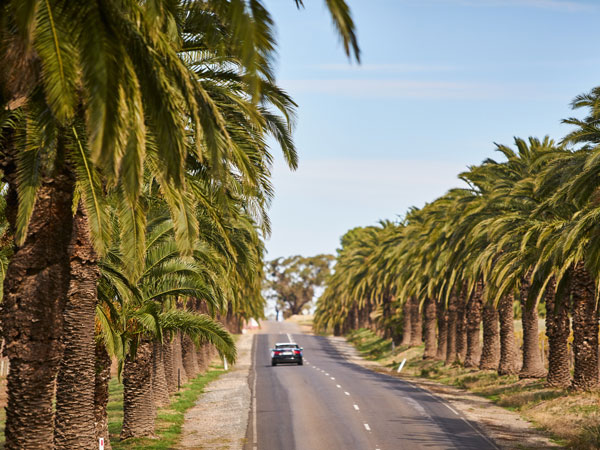
Admire the palm tree-lined road on your way to Seppeltsfield. (Image: South Australia Tourism Commission)
Seppelt, the label itself, is famous for its fortified and sparkling wines but don’t overlook its very drinkable table wines including the requisite shiraz. Get the most out of your visit to one of the finest Barossa Valley wineries with one of Seppeltsfield’s wine experiences, including the ‘Tasting of 100-year-old Tawny’ priced at $90 per person, the ‘General Wine Tasting Experience’ priced at $15 per person, the ‘Taste of History Tour’ which explores its historical 1878 Centennial Cellar priced at $109 per person and the ‘Centenary Tour’ where you’ll sample the Tawny from your birth year, priced at $189 per person. Alternatively, just roll up for free tastings at the cellar door.
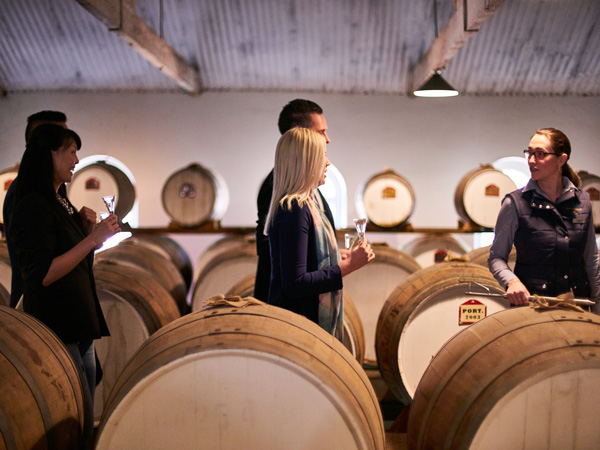
The immersive cellar door experience at Seppeltsfield. (Image: South Australia Tourism Commission)
An imposing bluestone pile with a 20-metre central tower, a croquet lawn and a cricket oval, the mammoth Chateau Tanunda is worth a lengthy stickybeak even before you get to its wines. When constructed in 1890, it was the largest winery in the southern hemisphere and the biggest building in South Australia, dwarfing the Parliament of South Australia. It also housed its own railway station, which was gifted to the state in 1911.
The Chateau rose from the valley floor when a group of local businessmen, including Johannes Basedow, had the bright idea of pooling the grapes of 560 Barossa growers and shipping the wine to Europe, where phylloxera lice in the 1870s devastated the wine industry. A century later, Chateau Tanunda still exports to European labels including Kangaroo Ridge and Grand Barossa.
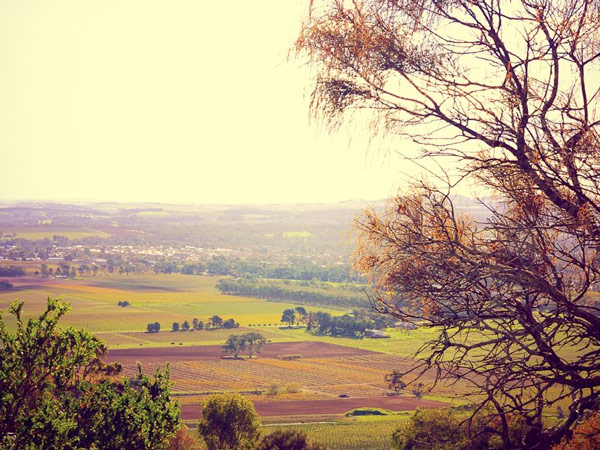
Barossa’s vintage town, Tanunda.
Owned by the Geber family since 1998, the Chateau was refurbished and reopened to the public in 2001. Its palatial Main Chateau Room is just the place for a medieval banquet with 400 of your nearest and dearest. The atmospheric cellar door, with its massive barrels, also houses the Barossa Small Winemakers Centre. When Barossa Valley wine time eventually calls, investigate the ‘Old Vines Expressions’ and ‘Everest’ collections for extremely quality tasting.
Offering spectacular views of the Barossa Valley ranges, Charles Melton Wines may not carry the enormous scale of other Barossa wineries but its quaintness makes it beloved for that reason alone. And the Kirche, which is German for church, offers luxurious on-site accommodation complete with a deep bathtub, poised perfectly to overlook the vines as you blur your afternoon into evening over your desired drop.
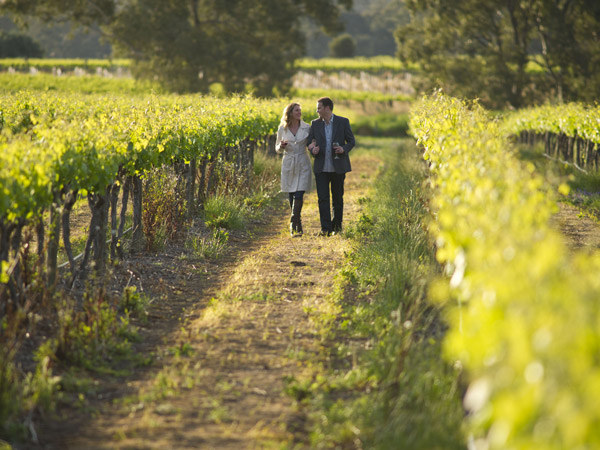
Take a romantic stroll at Charles Melton. (Image: South Australia Tourism Commission/ Mike Annese)
At Charles Melton, there’s no shortage of quality. The crowd-pleasing ‘Rose of Virginia’ rose, plus the famed ‘Nine Popes’ GSM, a French-style blend, and all the vineyard’s fabulous red table wines should see tastebuds of all sorts totally enchanted. With a reputation for blending stellar limited releases since 1984, the crew at Charles Melton Wines prove that quality can certainly outshine quantity in the endlessly diverse Barossa Valley.
Another tiny but mighty pick from the epic mass of Barossa wineries, Greenock Creek Wines is the place to go for big, bold reds guaranteed to impress at your next dinner party. Enter the weathered iron gates found along Seppeltsfield Road and wander down a short brick path to Greenock’s cosy wine room. There, you’re invited to sample the outstanding range of shiraz this team has expertly produced for almost 40 years.
Can’t seem to peel yourself away from the multi-award-winning drops? Book into one of Greenock Creek’s three self-contained Marananga Cottages for the evening. Queen-size beds set on wooden floors and amid antique furnishings, tea and coffee-making facilities and a continental breakfast are all on offer if you can beat the crowds and secure a reservation.
One of the region’s biggest family-owned wineries, Murray Street Vineyards feels like you’ve stepped into a home away from home. Squeeze past the clutter of wine-swilling groups guaranteed to be swarming the tasting room’s front deck if the sun’s shining, and you’ll find a snug sitting room fitted with throw rugs and cushions. It doesn’t get any more comfortable than this.
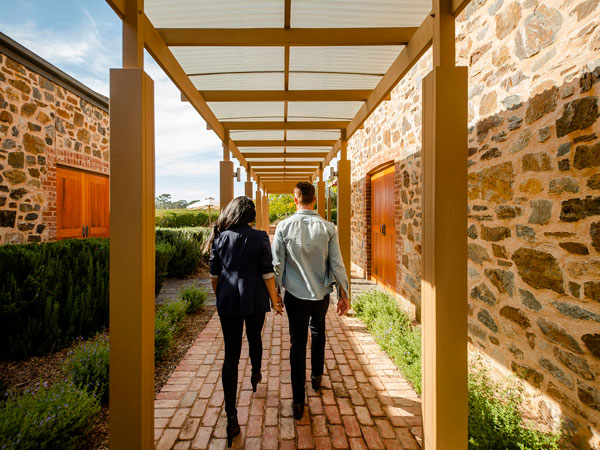
Soak up the wine and the views at Murray Street Vineyards. (Image: Barossa Grape Wines/ Sven Kovac)
The winery’s finest cabernet sauvignon and chiraz blends will be on offer, as share platters compiled with local produce will probably prove too tempting to refuse. Lean into Murray Street and throw out your day’s plans, opting to stay until dusk as unbeatable views of Barossa Valley’s Western Ridge come into their own – you won’t be the first, and you certainly won’t be the last.
Peter Lehmann was a fifth-generation Barossan and a wine legend, not for prodigious guzzling, but for saving many Barossa vineyards in 1979 when the big players threatened to sell local growers down the river – the Murray Riverland to be exact. Chief winemaker at Saltram at the time, he bought grapes from local growers himself and went out on his own. He chose for his logo the Queen of Clubs, the gambler’s card and it paid off.
Peter Lehmann Wines has been a public company since 1992 and continues to produce all its wine from Barossa fruit. Priceless Barossa heritage was preserved. None of the Lehmann growers participated in the notorious vine pull of the mid-80s. The grounds are grassy rather than grand and the cellar door is warm and welcoming. It’s all about the wine and the people. Both are exceptional. You can try many of Peter Lehmann’s 25 wines, as well as other cellar-door specials. Don’t hold back – they do freight.
Following in his famous father’s footsteps, David Franz is putting his own spin on the business of winemaking. Prodigal son of Peter Lehmann, David’s undeniable legacy led him right back to the Barossa Valley in 1998, when he struck up his own production while working as a full-time vineyard hand on his dad’s vines.
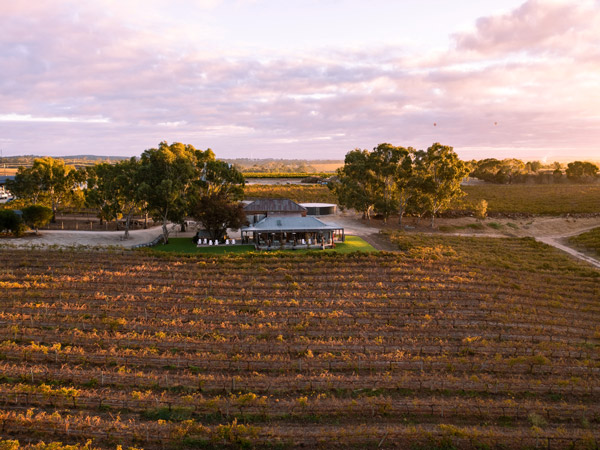
David Franz learnt the art of vinification from his father, Peter Lehmann. (Image: South Australia Tourism Commission)
It was among his old man’s property where he learnt everything he needed to know about the art of vinification and in 2000, he began crafting his own.
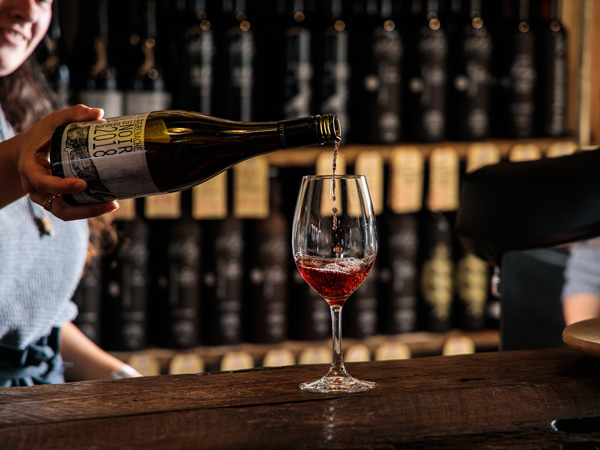
Head to the cellar door for a mix of big-bodied reds and crispy whites. (Image: Duy Dash)
Fast-forward to today and David Franz’s winery is a must-see on its own accord. Rough around the edges with scribbled chalkboards, knick-knacks and a mishmash of antiques, its cellar door is the property’s beating heart. A mix of big-bodied reds and crispy whites are available for tasting seven days a week.
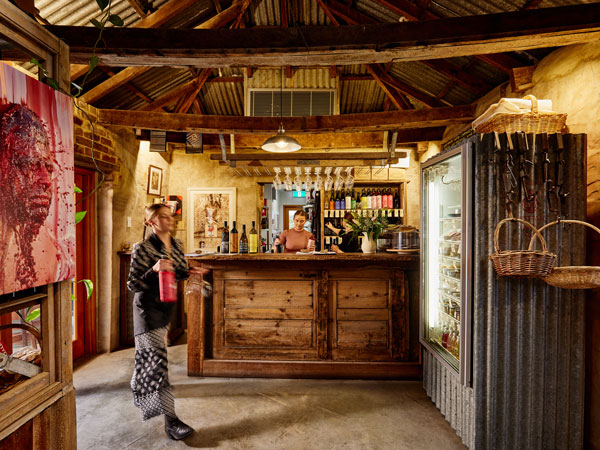
Feel at ease inside the eclectic cellar door. (Image: Barossa Australia)
St Hallett’s rustic, vine-covered yard is a great place to knock back a bottle with a light lunch. Established by the Linder family, one of the region’s most well-regarded wine families, in 1944, St Hallett focused on fortified wines in its early days – like most Australian wineries of the time – but since the 1970s and 1980s, has produced very well-regarded premium wines, especially the Old Block Shiraz, mostly under the direction of Stuart Blackwell, Barossa Winemaker of the Year in 2003 and a highly esteemed Baron of the Barossa fraternity member.
St Hallett doesn’t have its own vineyards but sources every drop from Barossa growers and all its plonk is produced right here. Warm staff offering light, breezy conversation peppered with a clear adoration for what they do for a living, complete one of Barossa’s most joyful cellar door experiences.
William Salter and his family settled in the Barossa in 1844, and the original homestead, Mamre Brook House, still proudly looks over the bluestone winery and is home to the chief winemaker at Saltram Wines. Outside of the impressive estate, Saltram red wine ranges from good to superb. And then there’s the food.
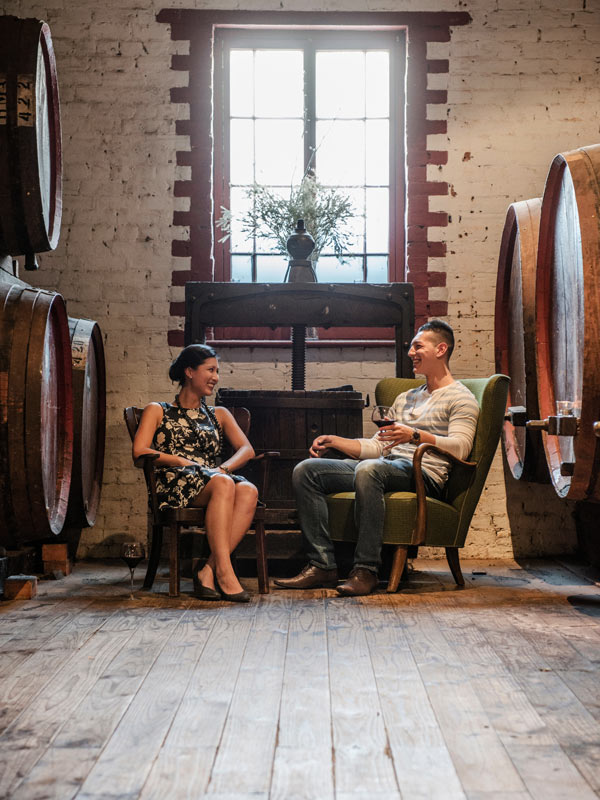
Relax into your tasting at Saltram. (Image: South Australia Tourism Commission/ Sven Kovac)
Its cellar door offers a seasonal pizza menu and wood oven snacks to help you wash down your wine, plus there’s Salter’s Kitchen which serves as a destination itself. Expect an Aussie barbecue-inspired menu with local produce grilled for lunch five days a week.
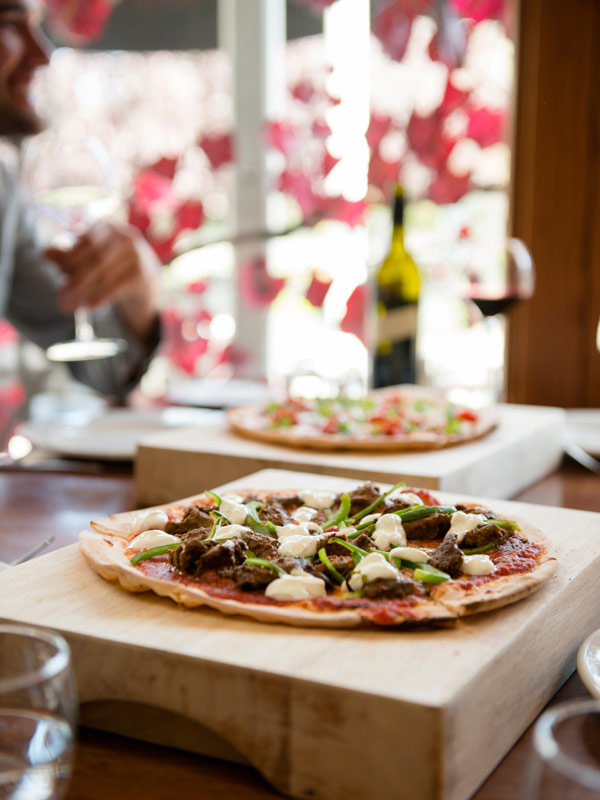
Sink your teeth into the tasty pizzas on offer in the onsite restaurant. (Image: South Australia Tourism Commission/ Sven Kovac)
For the full experience, opt in for a Saltram Grand Tour which tours the property’s ancient underground tunnels as the family’s rich history is explored. A shared lunch and tasting are also included, and it’s priced at $85 per person.
No visit to the Barossa Valley is complete without discovering the world-famous delights of Rockford Wines, home to the universally soothing Rockford Basket Press Shiraz. Acclaimed, and ultra-modest, winemaker Robert O’Callaghan’s tremendous blend is crafted using fruit from nearby regions including the Eden Valley, central Barossa and Ebenezer, and it is guaranteed to knock your socks off – if you can get your hands on it.
It’s not just the elusive Basket Press, which sells out rapidly once a batch is released, you’ll be keen to sample. Inside Rockford’s extremely small tasting room, which only adds to the historical cottage’s storybook magnetism, you’ll be treated to a free tasting of the label’s outstanding range of punchy reds and complex whites.
Although the label was established only in 1988, Grant Burge is a fifth-generation Barossa winemaker. The flagship Grant Burge wine is the Meshach Shiraz, named after Grant’s great-grandfather, who began the family’s winemaking tradition. It’s produced from vines almost a century old, hence the eye-watering price tag. But other ranges are much more wallet-friendly, and the Aged Tawny is terrific.
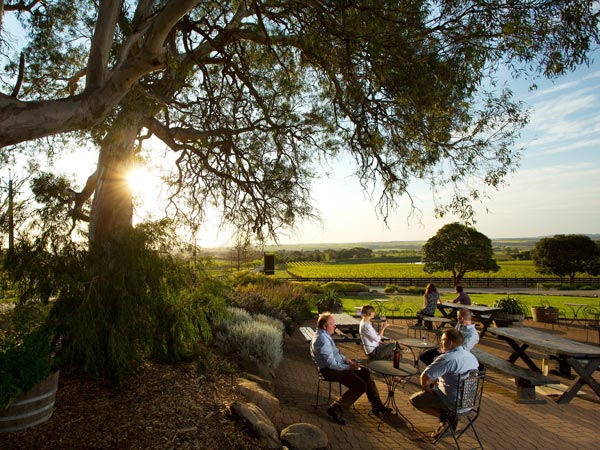
Take in expansive valley views at the cellar door. (Image: Grant Burge Wines)
Every drop comes out of the Barossa Valley, where Grant Burge owns a whopping 17 vineyards. The cellar door on Lily Farm Road offers wonderful views right across the Valley, but don’t miss the private dining room, the Meshach Cellar, if you’ve got something to celebrate. Exclusive tastings and a chef-catered meal can be provided in the stunning contemporary pile of bricks as you sit back and take in all those vistas.
This is no mere winery but “a state-of-the-art venue for the wine tourist” offering tastings and boxed sets to eliminate decision-making angst, plus a gallery of reverential photos detailing the company’s milestones, that feel more like sacred artworks. Jacob’s Creek is the Barossa wine industry encapsulated.
It all started on the banks of the eponymous, unremarkable creek where Johann Gramp planted the first commercial vines in 1846. Gramp’s original winery and cellar still stands, as does the restored stone cottage of the Jacob brothers, who first settled by the creek they named after themselves in 1842. But it’s the natural light-flooded cellar door that’s worth writing home about.

Choose from one of several immersive tasting experiences. (Image: John Montesi)
Double-storey floor-to-ceiling windows provide dreamy views across the sprawling property, while a series of “immersive” wine experiences let you sample the goods in theatrical style. Australia’s “top drop” is consumed in 60 countries, and plenty of folk want to see where it comes from, so the team work tirelessly to meet expectations.
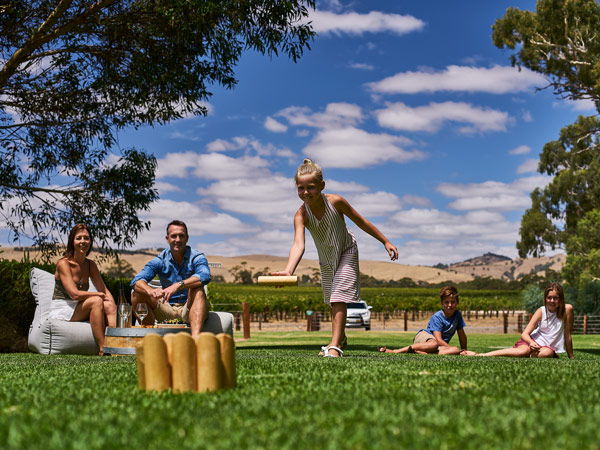
Take your time to enjoy the property on your visit. (Image: South Australia Tourism Commission)
While it technically belongs to Eden Valley, Henschke has proven a headliner for wine lovers touring the Barossa. Its ultra-sophisticated cellar door is worthy of architectural accolades alone, given the glamourous, black-framed glass doors juxtaposed against rustic brickwork and dramatic timber beams. But it’s the quality quaffing that steals the show because the Henschke family, all six generations of them, know a superstar drop when they nail one.
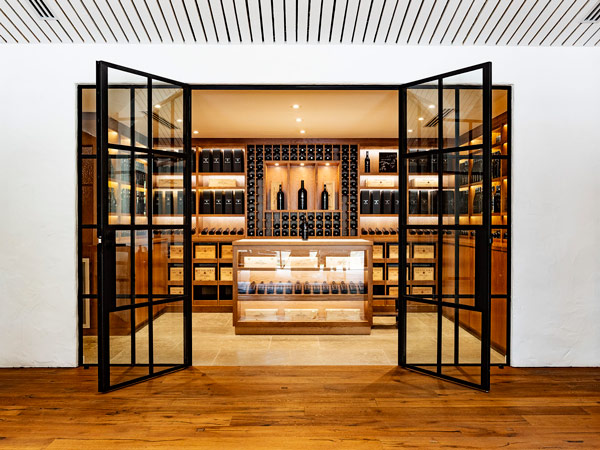
Inside the elegant Henschke cellar door. (Image: Barossa Grape Wines/ Sven Kovac)
You’ll likely be familiar with their Hill of Grace Shiraz, and its reputation has earned its own tasting experience; the exclusive ‘Hill of Grace experience’. Guests are invited to explore the glorious vines within a small group before visiting the working winery and are given a private tasting of the brand’s finest drops. But if it’s the broader collection you’re looking for, Henschke offers three fantastic, much more affordable, experiences that cover its complete works.
A one-stop-shop crammed with more than 100 wines from eight top-notch Barossa wineries, Artisans of Barossa offers a savvy cheat’s guide to quality Barossa Valley sampling. Local small batch success stories Spinifex Wines, Schwarz Wine Co., Sons of Eden, John Duval Wines, Purple Hands Wines, Hobbs of Barossa Ranges, Lienert Vineyards, and The Chaffey Bros. Wine Co. are brothers in arms at Artisans, a relaxed, inviting space where the region’s artistry is thoroughly celebrated.
Choose from several tastings including the ‘Rarities’ where guests are encouraged to sink into a cushy lounge by the floor-to-ceiling windows in a spectacular Wine Room, offering views out to the Barossa Ranges, alongside an edit of the Barossa’s most “rarest expressions”. Wash it all down with a bite from Delikatessen & Providore, the casual on-site eatery pumping out delicious sandwiches, salads, and snacks. Up for the works? Essen, the a la carte restaurant, offers imaginative dishes utilising Artisans’ very own kitchen garden.
Don’t let its no-frills appearance fool you. Turkey Flat Vineyard is utterly endearing; a no-nonsense cellar door offering two simple wine tastings: the Wine Flight priced at just $10 and pouring five current releases, and the Taste of Turkey Flat Experience for $30 which includes four current releases plus an excellent back vintage and cheese board.
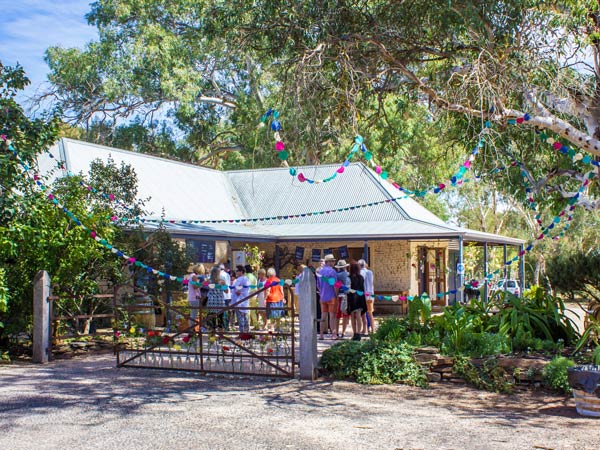
This quaint cellar door is more than meets the eye. (Image: Nathaniel Mason)
A restored butcher, hence the label’s popular Butchers Block Shiraz, the bluestone itself is homely, blending French provincial touches with raw, earthy furnishings. But it’s the dusty gravelled courtyard peppered with Parisian bistro tables and a spacious lawn you’ll struggle to peel yourself away from.
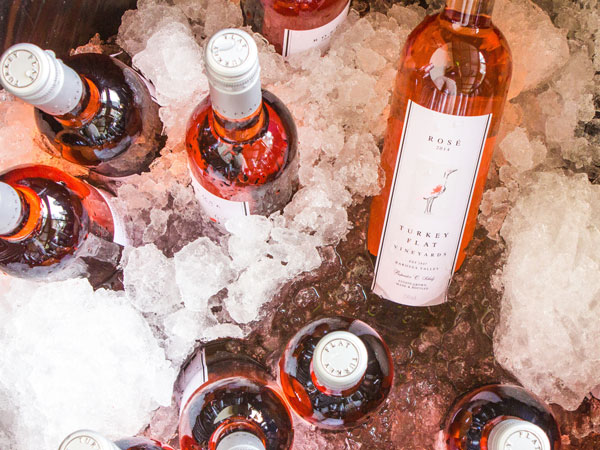
Sample a selection of the best on offer. (Image: Nathaniel Mason)
If you’re in the mood to get silly, pick up a bottle of the outstanding The Ancestor Shiraz to help celebrate the sun sinking over the vines of an afternoon. The mighty, highly applauded red is worthy of any excuse you can muster.
While we’re saluting great big, glorious lawns, let’s talk about the family-owned Gibson Wines, a local’s favourite within the Barossa with an especially beautifully manicured patch of the green stuff and one of the most Instagram-friendly buildings you’ll spy in the region.
Its 1850s mud and straw cottage, which once belonged to a blacksmith, dates back to the Barossa’s earliest European settlers, German emigrants who planted some of the earliest vines in the area. It’s an awesome sight, which is quite ironic as Gibson’s founder Rob Gibson, who spent more than two decades making wine for Penfold’s, is more grassroots than “instant celebrity”, as he explains on his website.
As for the wines, The Dirtman Shiraz, nodding to Gibson himself, is widely acknowledged while its sensational Australian Old Vine Collection Barossa Shiraz is crafted to complex perfection – and critics can’t get enough of it.
Another irresistible family-run winery, this one set in a tranquil hillside on the site of an old quarry, Bethany Wines transports you to Bordeaux. The stone building dates to 1981 but the winemakers, Rob and Geoff Schrapel, are fifth-generation Barossans whose ancestors first planted vines here in 1852.
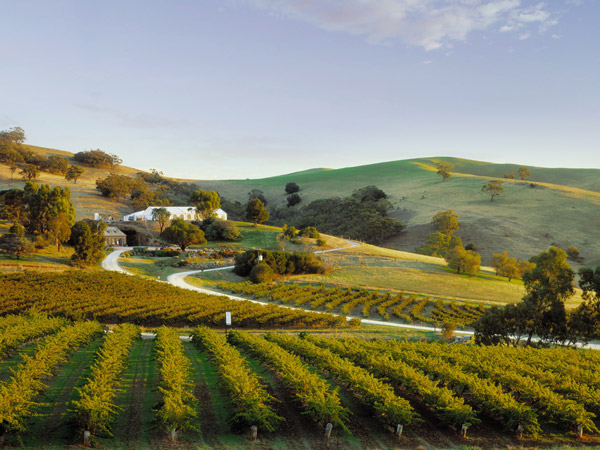
You’ll think you’ve been transported from the Barossa to Bordeaux. (Image: Nick Rains)
Today they have almost 40 hectares and devoted drinkers right around the globe. The hill it’s perched upon provides stunning panoramic views of the Barossa Valley floor, a dream vantage point to take in their seriously sensational GR Reserve Shiraz, Blue Quarry Riesling, and First Village Grenache.
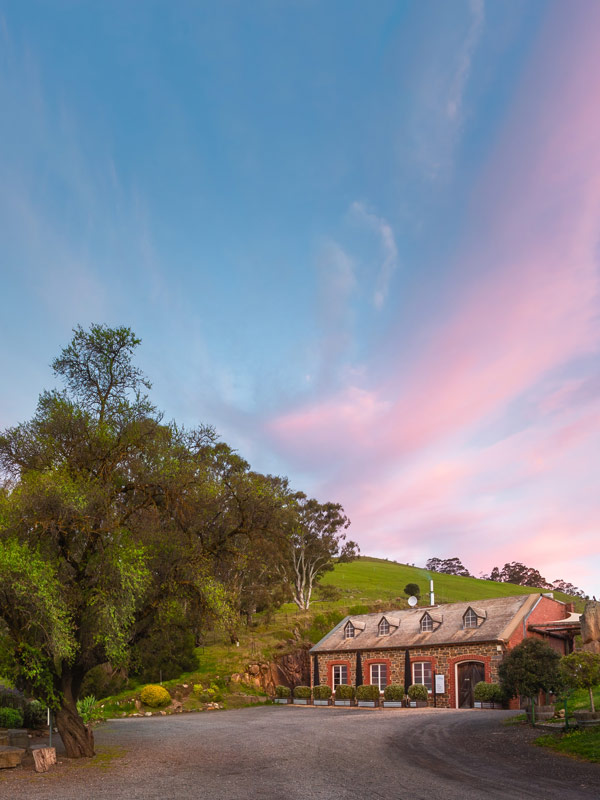
The family-run winery is set in a tranquil hillside. (Image: Michael Waterhouse Photography)
Yes, it’s a must-do as the most famous name in Australian wine but, it must be said, the visitor experience at Penfold’s is less than memorable. More drive-thru bottle shop than cellar door sensation. You rock up in the car park, go inside and buy your wines. No meandering grounds, picnic spots or tantalising wafting aromas from in-house eateries – although to be fair, the home of Penfold’s and its award-winning restaurant is at Magill in Adelaide.
And Penfold’s has never been a strictly Barossa operation. Multi-regional blending has been the go, even before the visionary Max Schubert created the iconic Penfold’s Grange Hermitage in 1951. The staff, however, are terrific. When we visited, they were enlightening and wining American, French and German as well as domestic visitors.
No, you can’t just front up and guzzle the Grange, and no, Penfold’s does not buy back its vintage wines from the public. But while in the Barossa, you’ll love learning about the fascinating story behind the Grange, especially the caustic reception on its release. “No one in their right mind will buy it, let alone drink it,” said one critic. Others couldn’t decide if it was an aphrodisiac or an anaesthetic. Another described the dominant flavour as “crushed ants.”
Stung by the hostile reception (and the expense of producing it), Penfold’s gave up on Grange in 1957, although Schubert continued to make it on the sly until 1960, when production resumed. In 1962, the 1955 vintage won first prize at the Sydney Show. At the 1979 Wine Olympiad in Paris, the 1971 Grange shocked local Rhone Valley heavyweights. The accolades have been pouring in ever since. Australian wine has never been the same.
An ultra-contemporary cellar door, filled with silky smooth timbers and warm shades of the Australian outback, is a blissful spot to catch a blazing sunset over the rolling hills of the Barossa, particularly on its generous-sized deck.
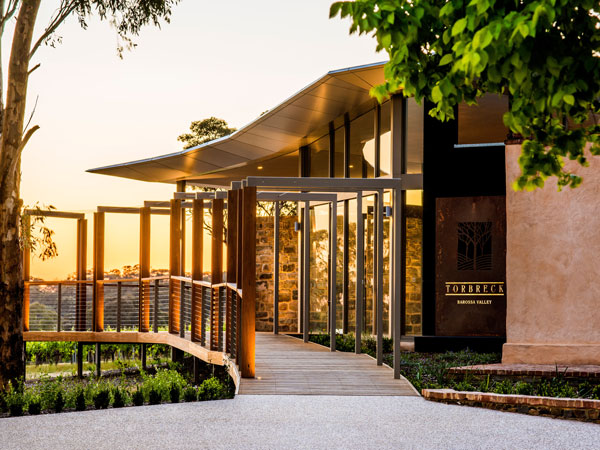
Catch a blazing sunset at the cellar door. (Image: Torbreck Vintners)
Wine tasting at Torbreck Vintners is an elegant experience and the team is passionate about their creations, not to mention the region and its bounty of ancient vines, which makes Torbreck that little bit more special.
The wine itself fits its sleek surroundings. Starting from the top, the infamous The Laird, its single vineyard Shiraz, is unmissable, but moving down the list is far from slumming it. RunRig, Torbeck’s shiraz/viognier blend, is highly commended in wine circles, while Les Amis, a grenache and The Factor, another shiraz, are straight-up stellar no matter your wine IQ.
To step inside the ultramodern Wolf Blass Visitor Centre is to appreciate Blass’s genius for marketing as much as winemaking. A glassy construction set around a grassy courtyard, it features four bars of tasting space, a private tasting room, great acoustics for recitals and the jolliest staff in the Barossa. Wolf Blass merchandise abounds, in between the savvily boxed sets at all price points. It’s impossible to walk out without at least one.
East German-born Blass started his own label in 1973 and within 10 years, Wolf Blass was a publicly listed company. Within 20 years, Blass was the International Winemaker of the Year. Today, Wolf Blass produces wine from vineyards right across South Australia and exports it to more than 50 countries.
Time your visit to Two Hands Wines in summer so you don’t miss Brutus Wine Bar & Garden, a magical outdoor space on the property with a bar housed inside a custom-built caravan dishing up charcuterie platters. It’s an idyllic scene, encompassing a courtyard and lush roomy lawn, to take in the serene Western Ranges atmosphere as you sample the brand’s alluring collections.
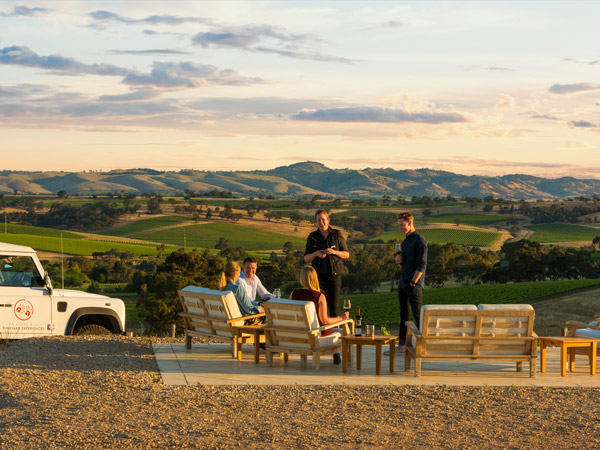
Soak up that serene Western Ranges atmosphere. (Image: South Australia Tourism Commission)
Masterfully crafting shiraz, grenache, and cabernet sauvignon, Two Hands presents multiple tasting flights as well as vineyard experience tours led by its down-to-earth team of winemakers. Some include extravagant lunches, so make sure your itinerary allows you the time to soak it all up at a gentle pace.
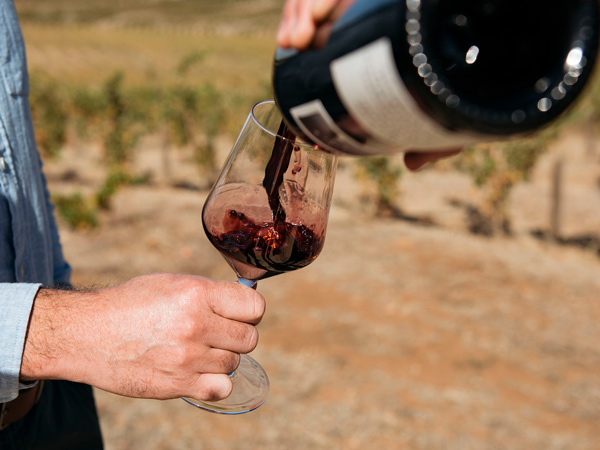
Do your best to sample as much of the range as possible. (Image: South Australia Tourism Commission)
Longing for the longest of lunches? Pair quality drops with top-tier culinary masterpieces at Hentley Farm Wines, often recognised for its fine dining restaurant The Atrium more so than the brand’s liquid gold goods.
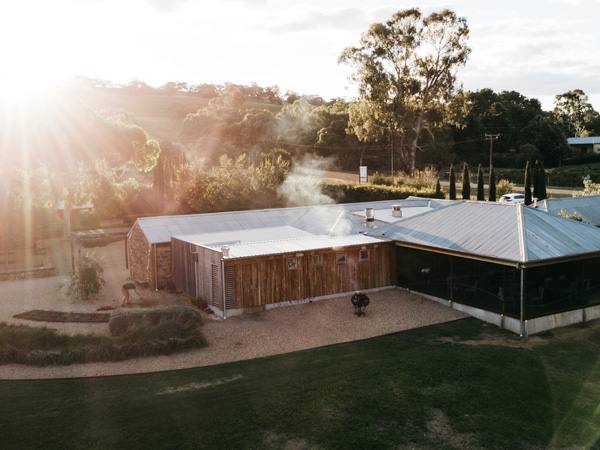
Drink and dine in picturesque surroundings. (Image: Erik Rosenberg)
It’s a shining star amid the Barossa Valley foodie scene, serving up wonderous creations using produce from the property’s farm garden beds and local farmers, and ingredients plucked from the wild surroundings of Greenock Creek.
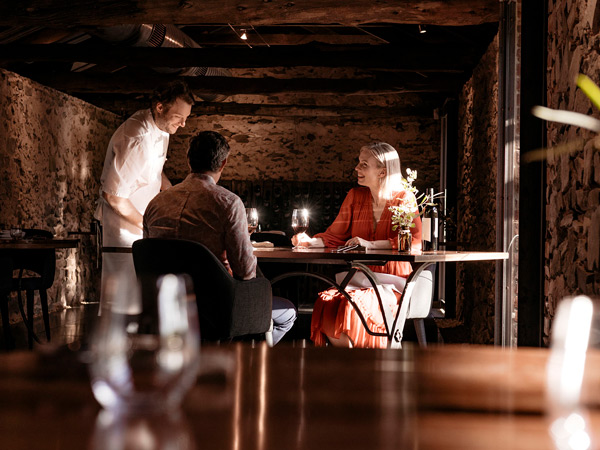
Hentley Farm Wines is renowned for its onsite restaurant. (Image: Barossa Grape Wine/ Sven Kovac)
Menus can, and should, be paired with Hentley Farm’s thrilling wines as well as its cleverly curated international wine list. As for cellar door tastings, guests are invited to try a large range of lovely reds including the much-buzzed-about The Beauty, as well as its viognier, which firmly holds its own in the mix.
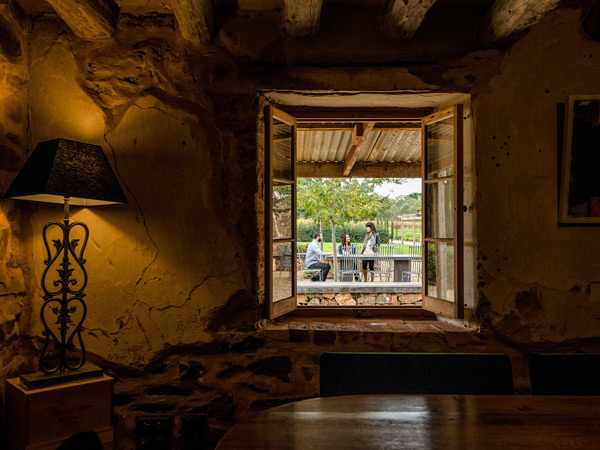
The charming cellar door. (Image: South Australia Tourism Commission/ Sven Kovac)
Famed for its exceptional skills in crafting balanced, ridiculously easy-to-drink reds, Elderton Wines is a family-run business filled with super fans of their home region. With a distinct passion for squeezing the best out of the Barossa’s marvellous winemaking conditions, the Ashmead clan go to great lengths to achieve spot-on smooth, or right-on robust results with every drop produced.
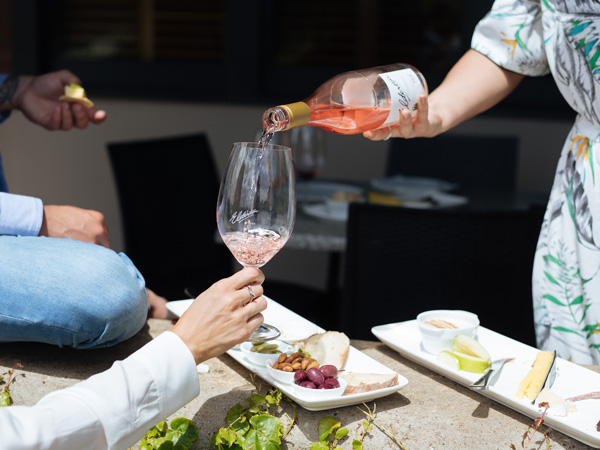
The wines here are ridiculously easy to drink. (Image: Josh Geelen)
The cellar door retains rich vintage materials, originally an elegant man cave (titled a gentleman’s bungalow when it was snapped up in 1918), and it feels grand yet homely sipping on the good stuff in there.
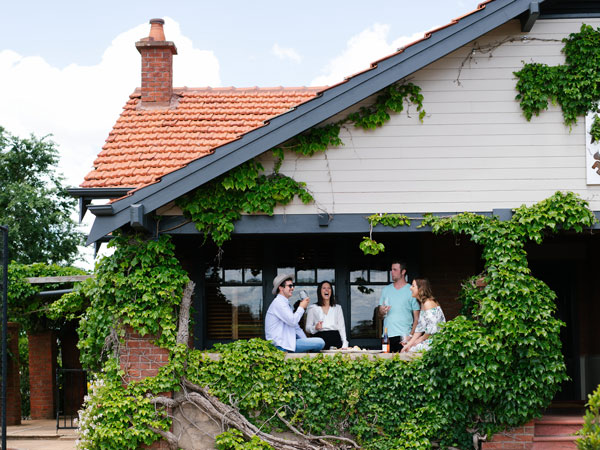
The cellar door at Elderton is the perfect mix of grand yet homely. (Image: Josh Geelen)
Choose from a wide range of tasting experiences, including the romantic Chocolate and Wine Matching, priced at $30 per person, which features four wines paired with everyone’s favourite indulgence.

There are numerous tasting experiences to choose from. (Image: Josh Geelen)
Best months to go: Any time but January – too hot for quaffing reds.
Most underrated aspect: The architecture and grounds of the wineries – almost as big a lure as the wine.
Most over-rated aspect: Penfold’s – not the wine but the visitor experience.
Watch out for: Exceptional staff who don’t make you feel like a Neanderthal for not knowing your verdelho from your viognier.
Best value encountered: Unsold export labels that can’t be sold here purely for packaging reasons. Buy them by the box.
Contact: Barossa Visitor Information Centre (08) 8563 0600
LEAVE YOUR COMMENT